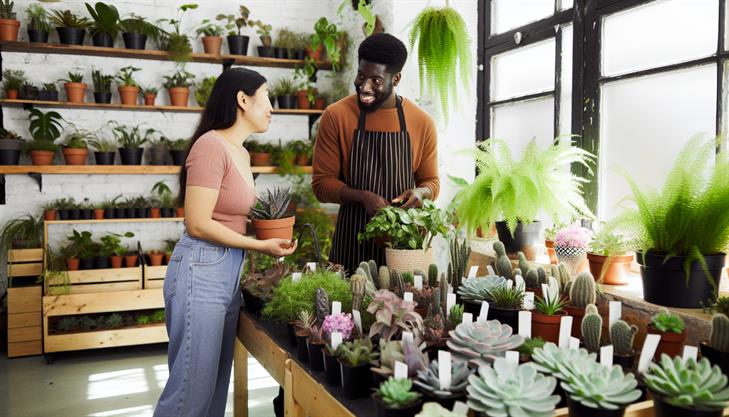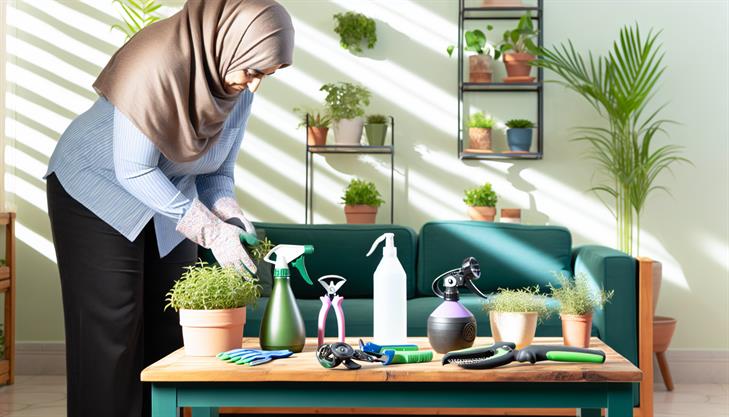In an age where digital screens dominate our lives, turning our homes into lush sanctuaries of greenery offers a much-needed respite for the soul. Houseplants not only elevate your living space aesthetically but also purify the air and boost your mood. Yet, if you’re new to the world of indoor gardening, you might find yourself overwhelmed by the myriad of options available. So, where exactly can you buy these verdant companions that will transform your home into a vibrant oasis? From specialty plant shops to online marketplaces and even your local grocery store, each source offers unique advantages. In this guide, we’ll explore the best places to purchase houseplants, taking you from novice to plant connoisseur in no time. Dive in to discover how you can curate your own indoor jungle with ease and confidence!
Exploring Local Nurseries: Your First Stop for Houseplants
When you’re looking to bring some greenery into your home, exploring local nurseries is an excellent starting point. Local nurseries offer a variety of houseplants and are ideally suited to help you choose just the right plants for your environment, while also providing helpful care advice tailored to your regional climate. Here’s a step-by-step guide to buying houseplants from local nurseries:
1. Research Nearby Nurseries:
Begin by searching online for nurseries in your area. Use search terms like "local plant nursery near me" or "where can you buy houseplants locally" to get a list of options. Alternatively, ask friends or use social media groups dedicated to gardening in your locality to get personal recommendations.
2. Visit and Explore:
Once you have a list, it’s time to visit these nurseries. Walking around and exploring what’s available allows you to get a feel for the variety of houseplants they offer. Pay attention to the health of the plants on display, as this can be an indicator of how well the nursery maintains its inventory.
3. Consult Staff for Recommendations:
Nursery staff are typically knowledgeable about the houseplants they sell and can offer invaluable advice on care and suitability for your home’s lighting conditions and your gardening experience level. Don’t hesitate to ask questions when deciding where you can buy your houseplants.
4. Check Plant Health:
Before purchasing, examine the plants closely. Look for signs of pests, such as spider mites or aphids, and check the soil for overwatering signs, like mold or fungus gnats. Healthy plants should have vibrant leaves, and their soil should be moist but not saturated.
5. Consider Care Requirements:
As you shop, think about the level of care each type of plant requires and honestly assess whether it fits your lifestyle and home environment. Some plants, like succulents, need less water and thrive in bright sunlight, whereas others, like ferns, prefer lower light and higher humidity.
6. Make Informed Purchases:
Once you have decided, make your purchase with confidence, knowing you have chosen plants suited to your home’s lighting, temperature, and aesthetic preferences. Buying from a local nursery often means you’re getting plants acclimated to local growing conditions, which can make them easier to care for once you bring them home.
7. Plan Your Setup:
After purchase, arrange your plants in their new home. Ensure each plant has the right amount of light and space according to its needs. You may need to repot some plants if they come in containers that are too small, but be careful not to disturb their roots excessively.
8. Utilize Additional Nursery Services:
Many local nurseries offer follow-up services, such as plant clinics or workshops on plant care, which can be extremely beneficial, especially for novice plant owners. Don’t hesitate to sign up for these educational opportunities to expand your knowledge.
Avoiding Common Issues:
Overwatering is one of the most common issues with houseplant care, especially for beginners. Ensure you understand the watering needs of each plant type you purchase. Also, be mindful of lighting requirements—place your plants in areas that match their needs for optimal growth.
Exploring local nurseries can be a rewarding experience that not only helps you find the perfect plants for your home but also supports local businesses and the broader community. By taking these steps, you can successfully introduce beautiful, thriving houseplants into your living space.
Online Plant Stores: Convenient Shopping Tips
Shopping for houseplants online offers a convenient way to bring greenery into your home without the hassle of visiting multiple physical stores. Here’s an easy-to-follow guide to navigating online plant stores and making informed purchasing decisions.
Where to Start Your Search
-
Choose a Reputable Online Plant Store: Begin by identifying trustworthy online retailers that specialize in houseplants. Popular options include:
- The Sill: Known for its wide range of plants and care resources.
- Bloomscape: Offers mature plants shipped directly from their greenhouse.
- Amazon: Provides a variety of houseplants from different sellers.
- Etsy: Great for finding unique and rare plant varieties from small businesses.
It’s important to read reviews and ratings to ensure you choose a reliable marketplace.
Browsing and Selecting Houseplants Online
-
Decide on the Type of Houseplant: Consider your home environment, space, and lighting conditions. Low-light houseplants such as snake plants or pothos are ideal for dim spaces, while succulents and cacti thrive in bright light.
-
Check Plant Descriptions and Care Instructions: Detailed descriptions help you understand the plant’s requirements. Look for information on:
- Light and water needs
- Size and growth rate
- Care difficulty
Some sites provide additional resources like plant care guides, which can be incredibly helpful for beginners.
Making the Purchase
-
Compare Prices and Shipping Options: Prices may vary significantly between stores. While browsing where to buy houseplants online, consider any shipping fees or available promotions that could affect the total cost.
-
Review the Return Policy: Ensure the store offers a customer-friendly return or exchange policy if the plant arrives damaged or in poor condition, providing peace of mind for your purchase.
After the Purchase
-
Unpack and Inspect Your Plant: When your plant arrives, carefully unpack it and check for any signs of stress or damage. Look for:
- Yellowing or wilted leaves
- Pest infestations
- Broken stems
Contact customer service immediately if you notice any issues upon arrival.
-
Acclimate Your Plant: Allow the plant time to adjust to its new environment. Place it in a suitable spot in your home based on its light needs and refrain from repotting too soon, as immediate transplant shock can harm the plant.
Additional Tips
- Subscribe to Plant Care Newsletters: Many online stores offer newsletters that include plant care tips and promotions, which can be beneficial in the long run.
- Join Community Forums: Sites like Reddit or Facebook groups offer valuable advice and support from fellow plant enthusiasts. Here, you can ask questions and learn from the experiences of others.
By following these steps, you’ll be well-equipped to select and care for houseplants purchased online, enjoying the convenience and variety these platforms offer. Remember, understanding your plants’ needs and maintaining a healthy environment will ensure they thrive in your home.
Comparing Physical Stores vs. Online for Best Deals
When it comes to purchasing houseplants, buyers have numerous options, each with its own set of benefits and drawbacks. Understanding where you can buy houseplants can help you find the best deals and ensure you select plants that meet your needs. Below, we explore the differences between physical stores and online shopping for houseplants, providing guidance to make the most informed purchase decision.
Physical Stores: Benefits and Tips
Physical stores, such as nurseries, garden centers, and local plant shops, offer a hands-on experience, allowing you to see and feel the plants before buying. This can be especially helpful for beginners who are unsure about choosing the right plant. Here’s a step-by-step guide on how to make the most of your visit to a physical store:
- Research Local Options: Start by researching local nurseries and garden centers. These stores often have knowledgeable staff who can offer personalized advice.
- Inspect the Plants: Examine the plants carefully for signs of health, such as vibrant leaves and absence of pests or disease. Avoid plants with yellowing leaves or a strong odor, which might indicate rot.
- Ask Questions: Don’t hesitate to ask sales staff about plant care requirements, growth habits, and any current deals or discounts.
- Consider the Climate: Choose plants that are well-suited for your local climate and indoor conditions.
- Plan for Transportation: Ensure you have a safe method for transporting your plants home to prevent damage.
Online Shopping: Advantages and Considerations
Shopping online offers unparalleled convenience and access to a wider variety of houseplants from around the world. It’s an excellent option for finding rare or specific plant varieties. Here’s how to effectively buy houseplants online:
- Choose Reputable Retailers: Select well-reviewed online plant shops. Websites like Etsy, The Sill, and Bloomscape are popular choices known for quality plants.
- Check Plant Descriptions and Customer Reviews: Reading reviews and descriptions can provide insights into the plant’s quality, packaging, and previous buyers’ satisfaction.
- Understand Shipping Conditions: Ensure the retailer offers secure packaging and quick shipping options. Sensitive plants may suffer if they spend too much time in transit.
- Know Return Policies: Familiarize yourself with the online store’s return policy in case the plant arrives damaged or is not as described.
- Stay Aware of Seasonal Deals: Many online stores offer seasonal sales or bulk discounts, which can be ideal for stocking up on plants.
Common Issues and Extra Tips
Whether purchasing in-store or online, it’s crucial to consider your light conditions, space, and commitment to plant care. Here are additional considerations:
- Light and Space Assessment: Ensure the plant’s light needs align with what you can provide. Large plants require sufficient space, so plan accordingly.
- Check for Pest Control: Both online and physical store-bought plants need to be checked for pests before integrating them with other houseplants.
- Watering and Soil Needs: Different plants have different care requirements. Ensure you understand these before purchasing to maintain plant health.
By integrating these strategies into your purchase journey, whether at a local nursery or an online plant shop, you can enjoy a satisfying experience and vibrant houseplants that thrive in your home.
Essential Tools and Accessories for Houseplant Care
When you’re looking to add lush greenery to your living space, knowing where to buy houseplants is a crucial step. Luckily, there are several options available, each with its advantages. Here’s a comprehensive guide to help you navigate where you can purchase houseplants that suit your needs and preferences.
1. Local Garden Centers and Nurseries:
Local garden centers and nurseries are excellent places to buy houseplants. They offer a wide range of plants, from common varieties to unique species. The staff at these centers typically have extensive knowledge and can offer personalized advice on plant care.
Setup Tip: Before visiting, check the garden center’s website or call ahead to ask if they specialize in houseplants, as some may focus more on outdoor plants.
2. Home Improvement Stores:
Chains like Home Depot or Lowe’s often have a garden section with a selection of houseplants. While the variety might be less extensive compared to a nursery, these places are convenient for a quick purchase.
Common Issue: Pay attention to the plant’s condition; they might not receive the same level of care as those in a dedicated nursery. Look for vibrant, pest-free leaves and a strong structure.
3. Online Retailers:
For those who prefer shopping from home, online plant retailers are an excellent option. Websites like Amazon, The Sill, and Bloomscape offer a diverse selection of houseplants, complete with detailed care instructions.
Setup Tip: When buying houseplants online, read customer reviews to gauge the quality and health of the plants upon arrival. Consider the shipping time and how that might affect the plant’s condition.
4. Farmers Markets and Plant Fairs:
Seasonal farmers markets or specialized plant fairs can be treasure troves for unique and affordable houseplants. These venues often feature local growers who can offer expert advice.
Additional Advice: Arrive early for the best selection, as rare or high-demand plants may sell out quickly.
5. Supermarkets and Big Box Stores:
Many supermarkets and big box stores, such as Walmart and Trader Joe’s, also sell houseplants. While the selection may be more limited and care less specialized, these stores offer convenience and frequently refresh their plant inventory.
Common Issue: Because these plants are not the main focus of the store, they might have experienced stress. Make sure to check for signs of neglect like wilting or yellowing leaves.
6. Social Media and Plant-swapping Groups:
Finally, exploring social media platforms or joining local plant-swapping groups can be a unique approach to acquiring houseplants. Platforms like Facebook Marketplace or community forums can connect you with fellow plant enthusiasts looking to trade or sell plants.
Additional Advice: When meeting someone to buy or swap plants, choose a public location, and inspect the plant thoroughly for pests or disease.
By considering these diverse buying avenues, you can find the perfect houseplants for your home, office, or outdoor spaces. Remember to assess each plant’s health before purchase, and don’t hesitate to ask questions from sellers, especially about plant care and maintenance. With these tips in hand, you’ll be well-equipped to create a thriving indoor garden.
Troubleshooting Common Buying Issues and Concerns
When considering where to buy houseplants, you’re presented with several options, each with its own benefits and potential issues. Navigating these options efficiently can enhance your plant-buying experience. Below is a comprehensive guide to help you make informed choices and address common concerns along the way.
-
Local Garden Centers and Nurseries: These are traditional and reliable choices when buying houseplants. Local nurseries often offer a diverse selection and have knowledgeable staff who can provide advice on plant care. To ensure a successful purchase, do a quick inspection of the plant, checking for vibrant leaves and no signs of pests or diseases. Moreover, their frequent availability of native plants ensures easier acclimatization to your home environment.
-
Online Plant Retailers: In recent years, buying houseplants online has become increasingly popular. Retailers like The Sill, Bloomscape, and Amazon offer a wide variety of plants. While convenient, this method can come with challenges, such as potential shipping damage or inaccurate product descriptions. To mitigate these issues, read customer reviews, check the retailer’s return policy, and order during moderate weather to prevent temperature-related shipping stress.
-
Big-Box Stores: Retail giants such as Home Depot and Lowe’s often sell houseplants at competitive prices. While selections may not be as varied or unique as specialized nurseries, these stores are usually convenient for quick purchases. A common concern is quality inconsistency. Always inspect the plant thoroughly for health issues before buying.
-
Local Farmers Markets: These markets can be treasure troves for seasonal and unique houseplants. By purchasing from local vendors, you often receive personal care tips and support small businesses. However, availability might be limited compared to other sources.
-
Online Marketplaces and Social Media: Platforms like Etsy and Facebook Marketplace offer another avenue to explore. They can feature both common and exotic plants. Be cautious of seller credibility, and if possible, check reviews or ratings before purchasing. Local pick-up can often help you avoid shipping issues associated with distance.
Setup Tips and Additional Advice:
- Research Care Requirements: Once you’ve identified a potential plant to purchase, research its care requirements to ensure it fits your lifestyle.
- Consider Space and Light: Match the plant’s light requirements to the conditions in your home. Some plants thrive in low-light conditions, while others need direct sunlight.
- Buying Tools and Supplies: Ensure you have necessary supplies such as pots, soil, and a watering can. Many stores where you buy houseplants stock these alongside their plants.
Common Buying Issues and Solutions:
- In-store Plant Damage: Occasionally, plants at big-box stores or marketplaces may be overlooked in terms of care, leading to health issues. Always check the leaves, stems, and general condition before purchasing.
- Online Shipping Damage: Minimize risk by choosing sellers with robust packaging policies and favorable return terms.
By following these guidelines, you can navigate the various options of where to buy houseplants, finding the perfect fit for your home while avoiding common pitfalls in the process.
In conclusion, buying houseplants has never been easier with the multitude of options available to plant enthusiasts today. Whether you prefer the tactile experience of selecting plants in-store at nurseries and garden centers or the convenience of online shopping, where you can often find rare and exotic species, there is something for everyone. Don’t overlook local farmers’ markets and plant swaps, which provide unique opportunities to discover new plants and support local growers.
It’s important to assess the credibility of the seller, check for plant care guides, and ensure that the plants are suited for your living environment. By applying these strategies, you can build a thriving indoor garden that adds a touch of nature to your home.
As a final tip, start by purchasing a few easy-care houseplants if you’re a beginner. This allows you to build confidence and experience before expanding your collection. Happy planting!


